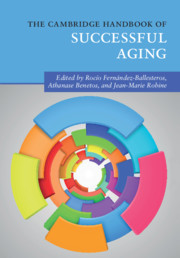Book contents
- The Cambridge Handbook of Successful Aging
- The Cambridge Handbook of Successful Aging
- Copyright page
- Contents
- Figures
- Tables
- Contributors
- Introduction
- 1 The Concept of Successful Aging and Related Terms
- 2 The Biomedical Bases of Successful Aging
- 3 Successful Aging and the Longevity Revolution
- Part I Biomedical Aspects
- 4 The Connection between Cellular Senescence and Age-Related Diseases
- 5 From Inflamm-Aging to Immunosenescence
- 6 Telomere Dynamics and Aging Related Diseases
- 7 Gene–Lifestyle Interactions in Longevity
- 8 Plasticity of the Brain and Cognition in Older Adults
- 9 Arterial Stiffness and Blood Pressure during the Aging Process
- 10 Prevention of Frailty
- 11 Preventive Effects of Physical Activity in Older People
- 12 Nutrition and Cognition
- 13 Nutrition, Muscle Function, and Mobility in Older People
- 14 Gerontechnologies and Successful Aging
- 15 Optimization of Drug Use in Older People
- Part II Psychosocial Factors
- Part III Socio-Demographic Issues
- Index
- References
4 - The Connection between Cellular Senescence and Age-Related Diseases
from Part I - Biomedical Aspects
Published online by Cambridge University Press: 10 January 2019
- The Cambridge Handbook of Successful Aging
- The Cambridge Handbook of Successful Aging
- Copyright page
- Contents
- Figures
- Tables
- Contributors
- Introduction
- 1 The Concept of Successful Aging and Related Terms
- 2 The Biomedical Bases of Successful Aging
- 3 Successful Aging and the Longevity Revolution
- Part I Biomedical Aspects
- 4 The Connection between Cellular Senescence and Age-Related Diseases
- 5 From Inflamm-Aging to Immunosenescence
- 6 Telomere Dynamics and Aging Related Diseases
- 7 Gene–Lifestyle Interactions in Longevity
- 8 Plasticity of the Brain and Cognition in Older Adults
- 9 Arterial Stiffness and Blood Pressure during the Aging Process
- 10 Prevention of Frailty
- 11 Preventive Effects of Physical Activity in Older People
- 12 Nutrition and Cognition
- 13 Nutrition, Muscle Function, and Mobility in Older People
- 14 Gerontechnologies and Successful Aging
- 15 Optimization of Drug Use in Older People
- Part II Psychosocial Factors
- Part III Socio-Demographic Issues
- Index
- References
Summary
- Type
- Chapter
- Information
- The Cambridge Handbook of Successful Aging , pp. 41 - 52Publisher: Cambridge University PressPrint publication year: 2019
References
- 2
- Cited by

